The body of an electric guitar is almost as recognizable as the music it creates. It’s the first visual element that captures attention, and for many musicians, it serves as a statement of their musical identity. Consider Jimi Hendrix and his iconic upside-down Stratocaster®, or Steve Vai and his signature Ibanez Jem®, complete with its distinctive monkey grip handle. These shapes are not just about aesthetics; they are integral to the guitar’s story and the player’s connection to their instrument.
In this guide, we will explore the fascinating world of electric guitar bodies, examining some of the most celebrated shapes, from the classic curves of the Stratocaster® to the unconventional angles of the Explorer® and Flying V®. Each body shape represents a blend of engineering, ergonomic considerations, and rich musical history.
Understanding Electric Guitar Body Shapes
Before diving into specific examples, it’s important to define what we mean by “guitar body shape.”
Guitar body shape refers to the outline and contours of a guitar's main structure, excluding the neck and headstock. This shape is crucial for a guitar's visual appeal and how it feels to play. While some shapes share similarities, like superstrats, each model boasts a unique body shape contributing to its individual look and feel.This design element is vital for several key reasons:
- Aesthetic Appeal: The shape is fundamental to a guitar’s visual identity. Iconic designs like the Fender Stratocaster® and Telecaster® are immediately recognizable and deeply embedded in the cultural image of electric guitars.
- Ergonomics: How a guitar feels when held and played is greatly influenced by its body shape. Factors like balance, weight distribution, and access to higher frets are all shaped by the body’s design. A comfortable body shape can significantly enhance a player’s experience, affecting their playing style and stamina.
- Sound Quality: Although less impactful than in acoustic guitars, the body shape of an electric guitar can subtly affect resonance and sustain. The distribution of mass and how strings interact with the body can influence tonal characteristics, although this is a debated point with minor overall impact.
- Playability: The body shape dictates how comfortably a guitar can be played in different positions, whether seated or standing. Some shapes are more suited for seated playing, while others are optimized for standing performance.
- Brand Identity: For guitar manufacturers, the body shape is strongly linked to brand identity and marketing. Certain shapes become synonymous with specific brands.
- Historical Context: Many body shapes carry historical weight, associated with particular eras, genres, or famous musicians, like Jimi Hendrix and the Stratocaster®. This historical connection can increase an instrument’s desirability and perceived value.
Common Electric Guitar Body Shapes
Considering these factors, we present a compilation of 40 of the most popular electric guitar body shapes, ranging from timeless classics like the Strat® and Les Paul® to modern designs like the Strandberg Boden®. Each entry includes design notes highlighting interesting and iconic aspects of the shape.
| Body Shape | Design Notes |
|---|---|
Fender Stratocaster® Fender Stratocaster Body Shape Fender Stratocaster Body Shape |
The Fender Stratocaster features a double-cutaway body with smooth, rounded edges and deep contours designed for player comfort. Known as the arm contour or forearm contour and the belly cut, these ergonomic features make the Stratocaster exceptionally comfortable, especially when playing while standing. Revolutionary upon its 1954 launch, the Stratocaster was conceived by Leo Fender, George Fullerton, and Freddie Tavares to improve upon the earlier Telecaster. The double cutaways enhance access to higher frets. The Stratocaster’s body shape not only achieved iconic status but also influenced countless guitar designs, becoming one of the most recognizable and imitated shapes in guitar history. |
Gibson Les Paul®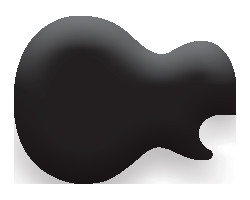 Gibson Les Paul Body Shape Gibson Les Paul Body Shape |
The Gibson Les Paul body shape is defined by its single-cutaway design, which still allows good access to the upper frets, and a carved top that enhances both aesthetics and player comfort. The Les Paul’s body is typically thicker and heavier than many other electric guitars, contributing to its characteristic sustain and rich tone. Designed by guitarist Les Paul and Gibson president Ted McCarty, it was introduced in 1952 as a premium model to rival Fender’s Telecaster. Les Paul’s original concept was to create a solid-body guitar to minimize feedback and maximize sustain, resulting in the iconic Les Paul shape. Its elegant and substantial form has become synonymous with rock and blues music, remaining largely unchanged and highly valued since its introduction. |
Fender Telecaster®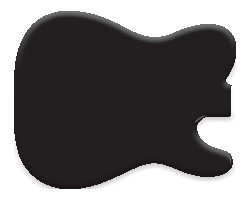 Fender Telecaster Body Shape Fender Telecaster Body Shape |
The Fender Telecaster features a distinctive single-cutaway body with a flat top and squared edges, often nicknamed the “slab body.” This functional and minimalist design reflects its origins in Leo Fender’s aim to create a straightforward, mass-producible electric guitar. Launched in the early 1950s as the Broadcaster, later renamed Telecaster, it was the first commercially successful solid-body electric guitar. Its design prioritized functionality and ease of manufacture. The Telecaster’s shape, lacking the body contours of later Fender models like the Stratocaster, was central to Leo Fender’s vision of a durable, easily made guitar with a clear, bright tone that would define many music genres. |
Gibson SG®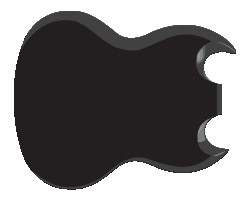 Gibson SG Body Shape Gibson SG Body Shape |
The Gibson SG stands out with its thin, flat-top body and double-cutaway design, providing unrestricted access to all 22 frets. Its pointed “horns” and beveled edges create a look that is both aggressive and ergonomic. Introduced in 1961 as a modern version of the Les Paul, the SG (Solid Guitar) was designed to compete with Fender’s sleek, contoured bodies. The SG quickly became an icon in its own right, known for its lighter weight and sharp, distinctive body lines. This design marked a departure from the thicker, single-cutaway Les Paul, reflecting Gibson’s move towards modernization and enhanced playability. The SG’s thinner profile and deep cutaways offered superior access to the higher frets. |
Gibson ES-335® Gibson 335 Body Shape Gibson 335 Body Shape |
The Gibson ES-335 features a semi-hollow, double-cutaway body, blending warmth and resonance with feedback resistance. Its rounded horns and elegantly curved body offer a classic aesthetic and comfortable playing experience. Introduced in 1958, the ES-335 was one of the first commercially successful semi-hollow electric guitars. Gibson aimed to bridge the tonal gap between hollow-body archtops and solid-body guitars. The ES-335’s body shape provides a versatile sound suitable for blues, jazz, and rock, making it a highly adaptable and enduring design. |
Gibson Flying V®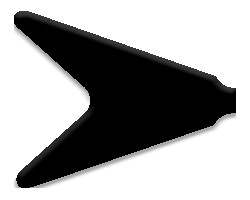 Gibson Flying V Body Shape Gibson Flying V Body Shape |
The Gibson Flying V is instantly recognized by its radical “V” shaped body, a design that was remarkably ahead of its time when introduced in 1958. With two pointed “wings” extending from a central point, the Flying V was part of Gibson’s attempt to inject modern flair into their lineup, appealing to the space-age fascination of the 1950s. Despite initial poor sales, the Flying V gained traction in the late 60s and 70s with the rise of rock and heavy metal. The bold design is not only visually striking but also functional, offering easy access to upper frets and allowing players to rest one wing on their leg when seated. It has since become an iconic model, strongly associated with rock and metal for its aggressive look and powerful sound. |
Gibson Explorer®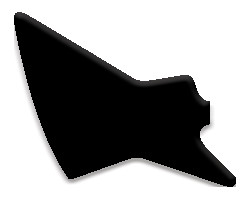 Gibson Explorer Body Shape Gibson Explorer Body Shape |
The Gibson Explorer features a bold, angular body shape with sharp points and edges, and an asymmetrical design that is undeniably aggressive. First launched in 1958 alongside the Flying V as part of Gibson’s Modernist Series, the Explorer was intended to attract guitarists with its futuristic aesthetic, mirroring the era’s fascination with space and innovation. Initially, it was considered too radical and sales were slow. Its large, flat slab body departed from traditional curves, but offered players a unique experience with good balance and easy high fret access. The Explorer’s design, ahead of its time, eventually found favor with rock and metal musicians in the 1970s and 1980s, becoming a symbol of rebellious musical expression. |
PRS Custom 24®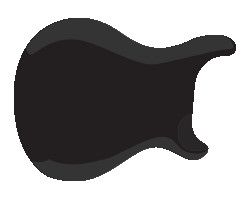 PRS Custom 24 Body Shape PRS Custom 24 Body Shape |
The PRS Custom 24 features a sleek, double-cutaway body shape with elegant curves and a slightly offset waist, offering a modern aesthetic and comfortable playability. Introduced in 1985 by luthier Paul Reed Smith, the Custom 24 was the first model offered by PRS Guitars and quickly became the company’s flagship instrument. Its design combined meticulous craftsmanship with innovative features like a 24-fret neck. The Custom 24’s body is typically made of mahogany with a maple top, often featuring figured maple, a signature of PRS’s luxurious style. Designed for versatile sound, excellent sustain, and stability, it’s favored by professionals across genres. |
Rickenbacker 360®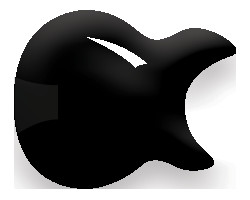 Rickenbacker 360 Body Shape Rickenbacker 360 Body Shape |
The Rickenbacker 360 is famous for its sleek, double-cutaway body with rounded edges and a distinctive “crescent moon” shape, giving it an art deco appearance. Introduced in the late 1950s as part of Rickenbacker’s Capri series, it quickly became one of their most iconic models. Its design was a departure from traditional shapes, featuring a thinner semi-hollow body with a characteristic “R” shaped soundhole known as the cat’s eye, contributing to its unique sound and look. The 360’s innovative body shape is not only visually appealing but also ergonomically designed for comfort, historically favored by musicians seeking a distinctive look and the bright, jangly Rickenbacker sound. |
Fender Jazzmaster®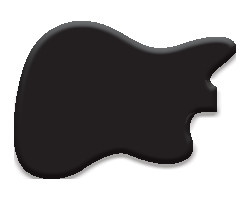 Fender Jazzmaster Body Shape Fender Jazzmaster Body Shape |
The Fender Jazzmaster features a distinctive offset-waist body shape with smooth, rounded curves and a relatively flat top. Launched in 1958, the Jazzmaster was originally intended for jazz guitarists, featuring innovative lead and rhythm circuitry and wider, mellow single-coil pickups. The offset body was ergonomically designed for seated players, common in jazz. However, it found its primary audience in surf rock in the 1960s and later in alternative and indie rock. The Jazzmaster’s body shape remains largely unchanged, a testament to its enduring design.Note: While the Fender Jaguar and Jazzmaster share a similar offset-waist design, giving them a distinctive asymmetrical appearance, they are not identical. The Jaguar typically has a shorter scale length and slightly different body contouring. |
Ibanez JEM®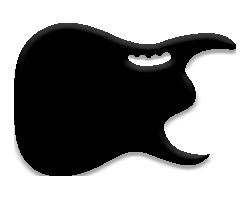 Ibanez Jem Body Shape Ibanez Jem Body Shape |
The Ibanez JEM features a highly stylized superstrat body shape with deep, sharp cutaways, an exaggerated lower “horn” for better upper fret access, and the signature “monkey grip” handle carved into the body. Created in collaboration with guitar virtuoso Steve Vai in the mid-1980s, the JEM was designed to meet Vai’s technical and visual demands, becoming one of the most player-focused guitars of its time. Its shape is tailored for high performance and comfort, with aesthetics reflecting Vai’s flamboyant style. A pioneering model for Ibanez, it incorporated advanced features like a 24-fret fingerboard and a floating tremolo, setting new standards for rock guitar playability and design. |
Jackson Soloist®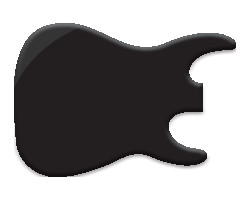 Jackson Soloist Body Shape Jackson Soloist Body Shape |
The Jackson Soloist features a contoured superstrat body shape with deep cutaways for unrestricted access to higher frets and a slim body profile for comfortable playability. Introduced in the early 1980s, the Soloist was among the first guitars to offer neck-through-body construction, enhancing sustain and stability—appealing to metal guitarists. The Soloist’s design catered to the demand for high-performance guitars for technical hard rock and heavy metal. Its refined, aggressive look, combined with top-tier hardware and electronics, solidified its place in Jackson’s lineup, influencing many genre designs. |
Gibson Firebird®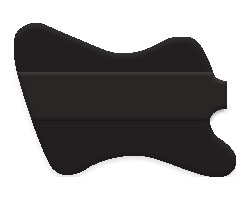 Gibson Firebird Body Shape Gibson Firebird Body Shape |
The Gibson Firebird features a unique offset body shape, often compared to a reversed Fender Jaguar or Jazzmaster, with a larger lower bout and pointed “wings.” Its distinctive look is further enhanced by its through-neck construction. Introduced in 1963, the Firebird was designed by automotive designer Ray Dietrich to compete with Fender’s modern electric guitar aesthetics. Dietrich’s design was radical for Gibson, featuring a nine-ply walnut and mahogany neck-through construction for sustain and a ‘reversed’ body shape, a dramatic departure from Gibson’s traditional designs. Initially met with mixed reactions, the Firebird has since become a Gibson icon. |
Gretsch White Falcon®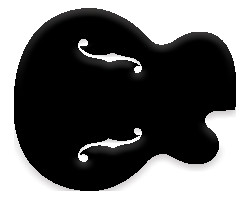 Gretsch White Falcon Body Shape Gretsch White Falcon Body Shape |
The Gretsch White Falcon presents an opulent, large-bodied, single-cutaway shape with an arched top and oversized f-holes, resembling a grand auditorium acoustic guitar but with a shallower depth typical of semi-hollow electrics. Conceived as the “Cadillac of guitars,” the White Falcon began as a concept model to showcase Gretsch’s craftsmanship and luxurious appointments. Popular demand led to production, making it a flagship model. Its elegant curves and grand dimensions remain a symbol of guitar luxury, coveted by collectors and players. |
Ibanez Iceman®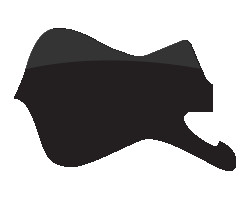 Ibanez Iceman Body Shape Ibanez Iceman Body Shape |
The Ibanez Iceman features a distinctive and aggressive body shape with sharp, angular contours and an asymmetrical double-cutaway design. Its body is marked by a hooked “horn” on the lower cutaway and an offset waist, giving it a bold, unconventional look that stands out from traditional guitar shapes. The Iceman’s unique shape and powerful sound made it popular in hard rock and metal genres. |
| Ibanez RG® | The Ibanez RG series features a sharp, angular superstrat body shape with deep cutaways for easy high-fret access and a sleek, aerodynamic appearance. Originating in 1987, RG (Roadstar Guitar) evolved from the Ibanez Roadstar II series, modified for the shredding and metal scenes. The RG body shape is designed for high-speed playability and comfort. Known for its pointed horns and slim profile, the RG became synonymous with the technical precision of 80s and 90s rock and metal guitarists, a staple in the Ibanez lineup. |
Jackson Rhoads®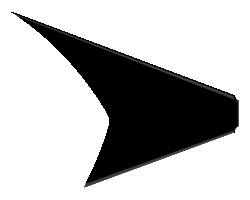 Jackson Rhoads Body Shape Jackson Rhoads Body Shape |
The Jackson Rhoads model features an asymmetrical V-shaped body with sharp, pointed ends, one side longer than the other, creating a distinctive and aggressive look. This design resulted from a collaboration between guitarist Randy Rhoads and Jackson founder Grover Jackson, aiming to create a striking stage guitar that broke from tradition. First introduced in the early 1980s, the Rhoads model was among the first Jackson guitars and quickly became iconic in heavy metal. Its bold, angular appearance and enhanced upper fret access catered to the technical and flamboyant style of heavy metal guitarists. |
ESP Eclipse®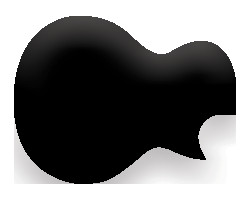 ESP Eclipse Body Shape ESP Eclipse Body Shape |
The ESP Eclipse features a single-cutaway body shape reminiscent of the classic Les Paul, but with modern modifications. It has a more contoured and sleeker silhouette with a slightly sharper cutaway and a reduced thickness for improved comfort and playability. Introduced by ESP in the early 1990s, the Eclipse met the demand for a contemporary, versatile version of the single-cutaway design, suitable for various styles including hard rock and metal. Its more aggressive lines and streamlined aesthetics blend classic inspiration with modern performance needs, establishing it as an ESP staple. |
B.C. Rich Warlock®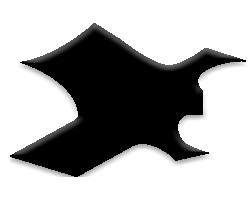 B.C. Rich Warlock Body Shape B.C. Rich Warlock Body Shape |
The B.C. Rich Warlock features an aggressive and angular body shape, characterized by sharp points and beveled edges, creating a very distinct appearance. Introduced in the early 1980s, the Warlock was designed by Bernie Rico of B.C. Rich to create unconventional, edgy guitars. The Warlock’s bold, geometric lines and dramatic silhouette quickly became a metal genre icon. Its extreme shape and high output pickups are designed for aggressive playing styles. |
Danelectro 59®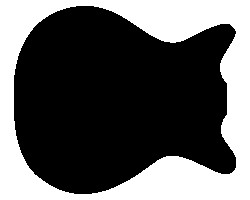 Danelectro 59 Body Shape Danelectro 59 Body Shape |
The Danelectro ’59 features a distinctive double-cutaway body shape, often called the “shorthorn” design, with smaller, symmetrical horns compared to models like the Danelectro ‘Longhorn’. The body typically uses a Masonite top and back with a poplar frame, known for lightweight and resonant qualities. Introduced in the late 1950s as part of an affordable guitar line, the ’59 is known for its unique construction and lipstick tube pickups, contributing to its jangly tone. Its simple design and distinctive materials were part of Danelectro’s goal to produce cost-effective yet playable instruments. The ’59 became a cult favorite and one of Danelectro’s most iconic models. |
EVH Wolfgang®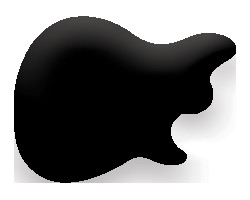 EVH Wolfgang Body Shape EVH Wolfgang Body Shape |
Designed by Eddie Van Halen, the EVH Wolfgang features a unique offset double-cutaway body shape with sleek, arched top contours and a distinctive horn design for comfortable playability and easy upper fret access. This signature model was developed by Eddie with Fender under the EVH brand, after years of experimenting with guitar designs and modifications. While reminiscent of classic styles, the body includes personal touches like a custom “belly” cut and forearm contour, uniquely suited to Eddie’s groundbreaking playing style. The Wolfgang is built for speed and high performance. |
Ernie Ball Music Man John Petrucci®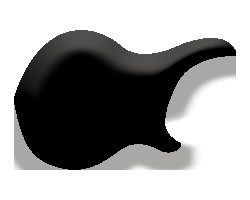 Ernie Ball John Petrucci Body Shape Ernie Ball John Petrucci Body Shape |
The Ernie Ball Music Man John Petrucci signature guitar series features a streamlined, modern double-cutaway body shape with rounded contours and a pronounced forearm scoop for enhanced playing comfort. Developed with Dream Theater’s John Petrucci, the body design reflects his ergonomic needs, featuring a slightly angled, extended upper horn for balance and a sculpted lower horn for high fret access. Petrucci models also often feature a recessed neck joint, further improving upper neck playability. This series has evolved through Petrucci’s input and Music Man’s craftsmanship. |
Gibson L-5®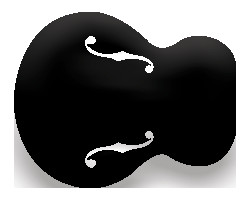 Gibson L5 Body Shape Gibson L5 Body Shape |
The Gibson L5 features a large, deep-bodied archtop design with a single-cutaway, f-holes, and a rounded Venetian-style body. As the first f-hole archtop guitar, designed by master luthier Lloyd Loar and introduced by Gibson in 1923. The L5’s body shape was revolutionary, inspired by orchestral string instruments, increasing volume and projection for jazz bands. Its iconic body shape, often crafted from high-quality woods with luxurious appointments, has made the L5 a symbol of the golden age of jazz. The L-5 is a benchmark for archtop guitars. |
Gretsch Duo Jet®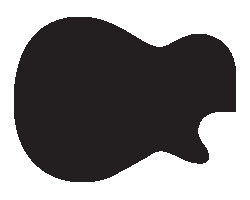 Gretsch Duo Jet Body Shape Gretsch Duo Jet Body Shape |
The Gretsch Duo Jet is characterized by its single-cutaway, chambered body shape with a distinctive, rounded cutaway reminiscent of the Les Paul. Introduced in the early 1950s, the Duo Jet was Gretsch’s response to the solid-body electric guitar trend, though its semi-solid design with a chambered mahogany body and maple top set it apart. The body’s comfortable size and often black finish with white binding (earning it “Black Beauty” nickname), made it visually and sonically distinct among 1950s and 1960s musicians. The Duo Jet’s body shape, known for balance and resonance, is associated with iconic players like George Harrison, a Gretsch classic. |
B.C. Rich Mockingbird®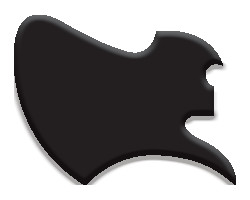 B.C. Rich Mockingbird Body Shape B.C. Rich Mockingbird Body Shape |
The B.C. Rich Mockingbird features an asymmetric and ornate body shape with a distinctively curved lower bout and extended upper horn, giving it a characteristic profile and balance. Created in the 1970s by guitar designer Johnny “Go-Go” Kallas and B.C. Rich founder Bernie Rico, the Mockingbird was part of the company’s move into avant-garde and exotic guitar designs, standing out in an era of guitar innovation. The design aimed to capture the flamboyance of rock and metal, providing visual flair and functionality with deep cutaways for upper fret access and comfortable body contour. |
| Schecter Hellraiser® | The Schecter Hellraiser series features a superstrat body shape with an arched top, deep cutaways for high fret access, and a contoured back for player comfort. This series, introduced in the mid-2000s, reflects Schecter’s focus on modern metal guitarists. The design blends classic strat-style playability with modern aesthetics and features. The Hellraiser is built for aggressive tones and fast playing. |
| Fender Mustang® | The Fender Mustang® guitar features a distinctive short-scale, offset body shape with rounded contours and a compact overall design. The body is smaller than many standard electric guitars, contributing to its lightweight and comfortable playing experience, favored by players preferring a more manageable instrument size. The Mustang’s smaller size and comfortable shape make it popular for students and players with smaller hands. |
Fender Starcaster®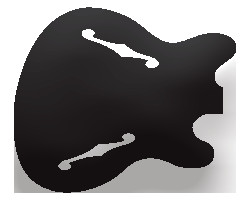 Fender Starcaster Body Shape Fender Starcaster Body Shape |
The Fender Starcaster features a unique offset semi-hollow body shape with a distinctively curved outline and pronounced, asymmetrical cutaways, creating a standout silhouette. Launched in the mid-1970s, the Starcaster was Fender’s entry into the semi-hollow market, distinguished by its bold design, blending Fender’s solid-body expertise with hollow-body resonance. The Starcaster’s large, bound f-holes were a departure from Fender’s traditional designs, intended to capture the era’s aesthetics while providing the warmth and depth of semi-hollow tones. |
Charvel San Dimas®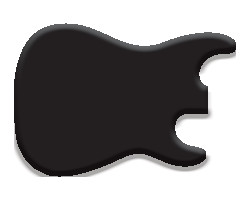 Charvel San Dimas Body Shape Charvel San Dimas Body Shape |
The Charvel San Dimas style guitar features a sleek superstrat body shape, known for deep cutaways that allow easy high-fret access and a contoured body for player comfort. This model pays tribute to the hot-rodded guitars from the Charvel shop in San Dimas, California, during the late 1970s and early 1980s. The San Dimas is designed for high-speed playing and rock performance. |
PRS Single Cut®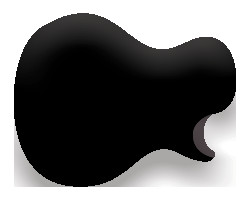 PRS Single Cut Body Shape PRS Single Cut Body Shape |
The PRS Singlecut features a thick, single-cutaway body shape with an elegantly carved top. The design is reminiscent of the classic Les Paul but with Paul Reed Smith’s unique touches, such as a more contoured, comfortable body shape. Introduced in the late 1990s, the Singlecut was PRS’s entry into the single-cutaway market. Its slightly offset waist complements its classic outline, blending traditional aesthetics with modern playability. The PRS Singlecut aims for a balance of classic tone and modern refinement. |
Parker Fly®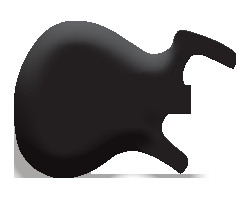 Parker Fly Body Shape Parker Fly Body Shape |
Known for its lightweight design and composite materials, the Parker Fly is a modern guitar with a unique and ergonomic shape. Its body is designed for minimal weight and maximum resonance, utilizing advanced construction techniques and materials. The Fly is known for its exceptional comfort and versatility. |
Suhr Modern®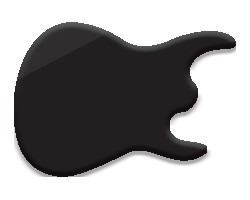 Suhr Modern Body Shape Suhr Modern Body Shape |
The Suhr Modern features a sleek and ergonomic double-cutaway body shape with distinctive contouring for enhanced playability. It represents a modernized evolution of the classic superstrat design, with a more sculpted and refined aesthetic. Introduced by Suhr Guitars in the late 2000s, the Modern caters to contemporary guitarists, combining easy high-fret access with balanced comfort whether standing or sitting. The body shape features a distinctive arm contour and a ribcage cut on the back. The Suhr Modern is designed for high performance and versatility. |
Mosrite Ventures® Mosrite Ventures Body Shape Mosrite Ventures Body Shape |
The Mosrite Ventures model exhibits a distinctive slim, double-cutaway body shape with sharp, pointed horns and a long, sweeping lower bout. This design was a collaboration between Semie Moseley, founder of Mosrite, and The Ventures surf rock band in the early 1960s. The body’s deep cutaways allowed for easy high-fret access, while its sleek, aerodynamic aesthetic captured the Space Age spirit and California surf culture. It stood out from traditional shapes, becoming a symbol of Mosrite’s innovative guitar craftsmanship. The Ventures model is iconic for its association with surf rock music. |
Gibson Les Paul Junior® (Double Cut)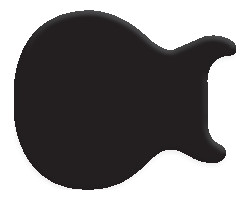 Double Cut Les Paul Jr Body Shape Double Cut Les Paul Jr Body Shape |
The Les Paul Junior Double Cut features a symmetrical double-cutaway body shape. Introduced by Gibson in 1958, the Les Paul Junior was originally designed as an affordable, entry-level version of the Les Paul. The Junior’s double-cutaway design was part of a mid-century trend towards more player-friendly guitar shapes, offering a no-frills approach with its straightforward design and robust build, making it a favorite for players seeking a raw, powerful guitar. The Les Paul Junior is known for its simplicity and powerful tone. |
Ibanez S Series®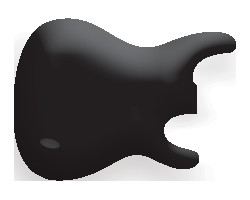 Ibanez S Series Body Shape Ibanez S Series Body Shape |
The Ibanez S Series, also known as the Saber Series, is renowned for its sleek, contoured, and thin body shape. Introduced in the late 1980s, the S Series was designed to meet guitarists’ demand for lighter, more ergonomic instruments that still sustained tone. The body is notable for its slim profile, tapering to a razor-thin edge around the guitar’s contour. This design was a significant departure from bulkier traditional bodies, aiming for comfort and playability without sacrificing sound quality. The Ibanez S Series is built for speed, comfort, and a lighter weight. |
Dean ML®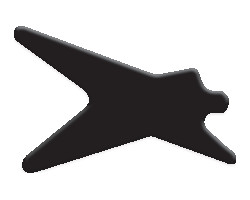 Dean ML Body Shape Dean ML Body Shape |
The Dean ML features a distinctive and radical body shape with an oversized, pointed double-cutaway design, combining elements of the Gibson Flying V and Explorer. Created by Dean Zelinsky in 1977, the ML was designed to be a visually striking stage guitar with an eye-catching silhouette. The ML’s shape is characterized by equal-length, pointed “wings” extending from the body, providing unique balance. It gained iconic status largely thanks to “Dimebag” Darrell Abbott of Pantera, who famously used a Dean ML, contributing to its legacy as a heavy metal and hard rock guitar. The Dean ML is synonymous with Dimebag Darrell and aggressive metal tones. |
Fender Thinline Telecaster® 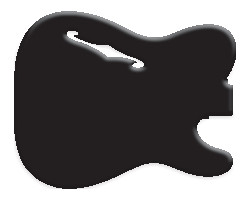 Fender Thinline Telecaster Body Shape Fender Thinline Telecaster Body Shape |
Fender Thinline models, like the Telecaster Thinline, feature a semi-hollow body design with a single f-hole on the upper bout, a distinctive variation on the classic solid-body shape. Introduced in the late 1960s, the Thinline was Fender’s effort to reduce the Telecaster’s weight and offer a different tonal option, blending solid-body twang with hollow-body resonance. The body retains the iconic Telecaster silhouette with its single cutaway, but the added f-hole and mass distribution give the Thinline a unique aesthetic and warmer tone. The Thinline Telecaster offers a lighter weight and more resonant tone than a standard Telecaster. |
Steinberger GL®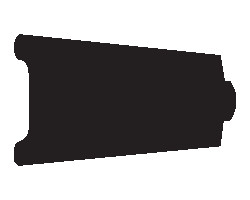 Steinberger GL Body Shape Steinberger GL Body Shape |
The Steinberger G&L series features a minimalist and compact headless body design, known for its rectangular and almost featureless shape, a stark departure from traditional guitar bodies. Developed by Ned Steinberger in the early 1980s, the G&L was part of his innovative approach to guitar design, focusing on functionality and playability. The headless design, with a unique direct-pull tuning system at the bridge, created a lighter, more balanced instrument with improved tuning stability. Made from composite materials instead of wood, Steinberger guitars were groundbreaking, offering durable, travel-friendly options with a distinctive look and feel. Steinberger guitars are known for their futuristic design and tuning stability. |
Kiesel Aries®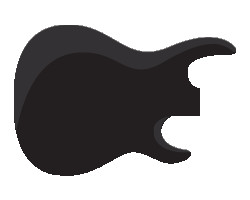 Kiesel Aries Body Shape Kiesel Aries Body Shape |
The Kiesel Aries guitar features a sleek, modern superstrat body shape with an aggressive beveled top, deep rear body cutaways, and sculpted, sharp horns for easy high-fret access. This model reflects Kiesel’s contemporary design philosophy, blending cutting-edge aesthetics and playability for modern musicians. Introduced as part of the rebranding from Carvin to Kiesel Guitars, the Aries represents the company’s commitment to innovation and custom-built quality. The Kiesel Aries is designed for modern high-performance playing styles. |
Strandberg Boden®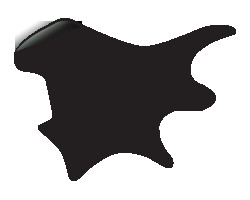 Strandberg Boden Body Shape Strandberg Boden Body Shape |
The Strandberg Boden features a distinct, compact, and lightweight body shape with an ergonomic design characterized by multi-faceted angles and curves, including arm bevel, ribcage contour, and a pronounced upper horn extending towards the neck. This headless design, a radical departure from tradition, was developed by Swedish designer Ola Strandberg. The Boden’s design originated from ergonomic research, aiming for a highly comfortable and playable instrument for extended use without physical strain from heavier guitars. Introduced in the late 2000s, the Strandberg Boden quickly gained popularity with progressive metal guitarists for its innovative features like the EndurNeck™ profile and unique body shape, balanced for both standing and seated playing. The Strandberg Boden is known for its ergonomic design and lightweight construction. |
Final Thoughts
This overview demonstrates the evolution of electric guitar body design, from the classic contours of the Stratocaster (largely unchanged since 1954) to the futuristic Strandberg Boden. These 40 shapes represent more than just instrument forms; they embody innovation, cultural shifts, and artistic expression that have defined the electric guitar’s role in music across generations.
Each shape tells a story of its era and the musicians who embraced it.
From the timeless elegance of the Les Paul to the radical edge of the B.C. Rich Warlock, and the ergonomic precision of the Kiesel Aries, these designs have indelibly shaped the music industry. They have inspired countless musicians, from hobbyists to stadium headliners, and will continue to inspire as luthiers worldwide push the boundaries of electric guitar design.

